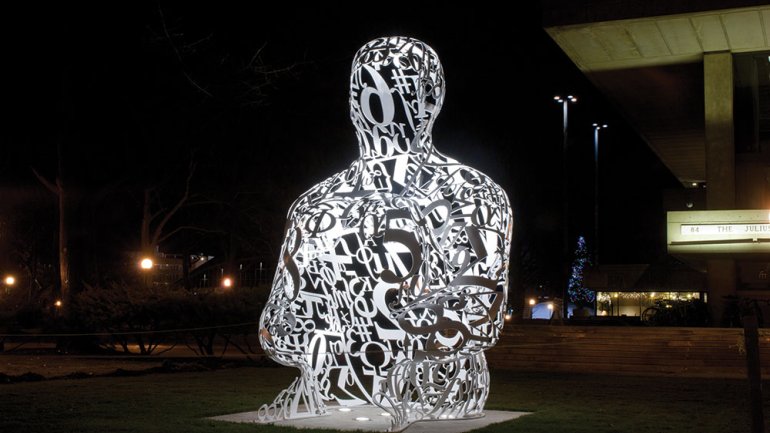Number Crunchers
Number Crunchers
The Klein bottle is a mathematical concept developed in the 1880s – a surface with only one side. Rather than enclosing a space as a regular bottle would, the top part of the form curves back so that the inner side of the surface merges with the outer – and the form encloses no volume at all. Instead, as with a Möbius strip, inside and outside spaces become one. Sculptor Bathsheba Grossman, who splits her time between Santa Cruz, California, and Somerville, Massachusetts, makes the concept even more curious with her 3D-printed 2008 Klein bottle opener in stainless steel (which really opens bottles).
As Philadelphia jewelry artist Maria Eife sees it, digital communication often ends up as miscommunication. That’s the thinking behind her laser-cut felt Binary Collection, which she launched in 2009. Each necklace spells “What?” in binary code, a computer language in which each letter is represented by a series of zeros and ones.
Sienna Morris calls her intricate drawing technique “numberism,” and the Portland, Oregon, artist applies it to this portrait of Albert Einstein (detail, 2012). The drawing pays tribute to several of Einstein’s contributions to the scientific community: the theory of relativity, Brownian motion (which he used to proved that molecules exist), the photoelectric effect (wave-particle duality), and the Einstein field equations (part of the theory of relativity).
Sarah Metts-Murphy translates phone numbers, Social Security numbers, birth dates, and other numbers that define us into three-dimensional jewelry. The Great Barrington, Massachusetts, artist begins by plotting each sequence of numbers on graph paper, making 90-degree turns for each new number. In the Family Portrait necklace (2012), for example, Metts-Murphy’s mother’s birthday – April 4, 1964 (see inset) – is depicted in the small form at upper left.
From a distance, Barcelona sculptor Jaume Plensa’s Alchemist (2010), on the campus of the Massachusetts Institute of Technology, is a thinking man, seated. Up close, the sculpture is an abstract mass of numbers, formulas, and symbols. The knees of the figure are open, inviting the viewer to explore the space inside – and perhaps to enter the sphere of the
mathematician.
Euclid defined a platonic solid as a three-dimensional object with flat faces and straight edges in which the same number of faces meet at each point. There are exactly five platonic solids, which woodturner Bob Rollings has captured in wood. The Toronto artist, whose interest in geometry flows from a life spent making cabinets, goes further with the solids (2010 – 12), inlaying intricate patterns.
Erik Demaine, with his father, Martin, has long been interested in the connections between mathematics and art. A computer science professor at MIT, Demaine is particularly interested in origami, as seen in 0313 (2012), part of the Demaines’ Ocean series. The sculpture is made up of several interacting pieces, each of which is folded by hand from a circle of paper, using a compass to score the creases and cut out a central hole. “The transformation of flat paper into swirling surfaces,” the artist writes,“creates sculpture that feels alive.”
A mathematical curve, the Koch snowflake is generally shown as a circular pattern with endlessly intersecting equilateral triangles as its basis. In this vivid tapestry (2012), Donna Loraine Contractor represents the snowflake in a linear way. The Albuquerque, New Mexico, weaver’s goal with this and other tapestries in her Universal Language series is to illustrate not only geometrical principles but also the “beauty of mathematical ideas.”

